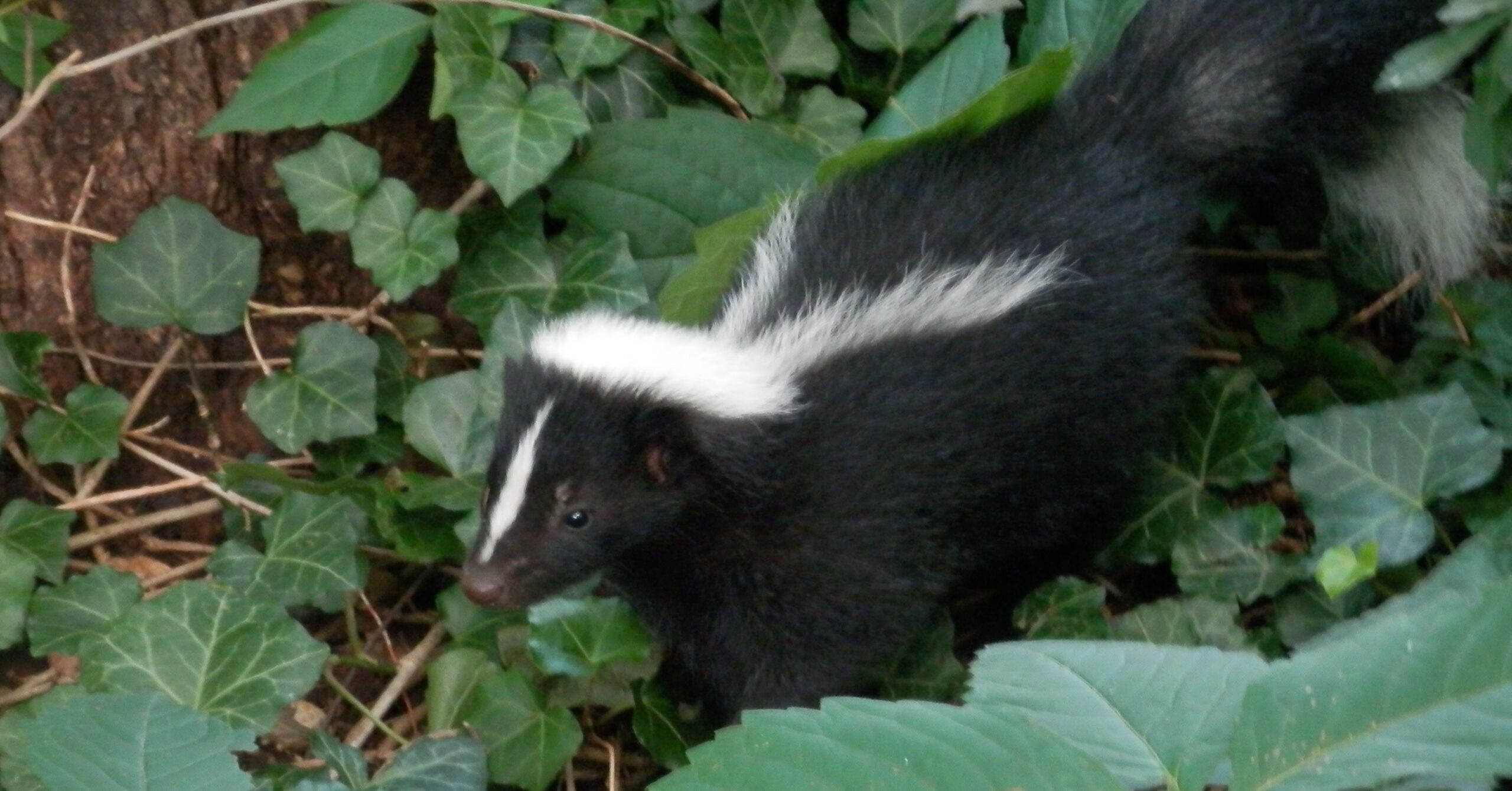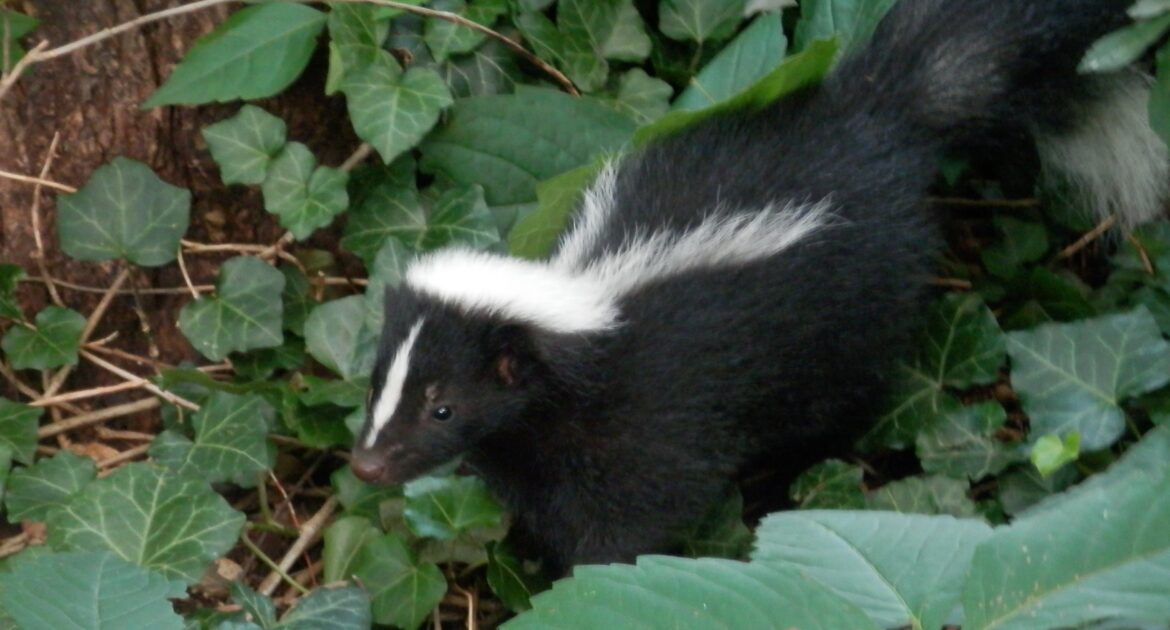Most people recognise skunks by their black-and-white stripes, but did you know those stripes are a key survival tool? They warn predators to back off unless they want a blast of smelly spray. Pretty impressive, right?
But here’s something even more fascinating: researchers have found that a skunk’s stripes can actually change based on the number of predators around. In areas with more predators, their stripes are bold and even. In safer spots, the stripes are less defined.
So, what does this mean for you? Understanding skunk behaviour can help you handle them more effectively if they wander onto your property. At Skedaddle Humane Wildlife Control in Ottawa, we use humane, proven methods to keep skunks and other wildlife away from your home. Keep reading to learn more about what these stripes reveal and how we can help!
Why Do Skunks Have Stripes?
Skunks are hard to miss with their bold black-and-white stripes. But those stripes aren’t just for style—they serve a critical purpose in nature. These striking patterns send a clear warning to potential predators: “Stay back, I’m not worth the trouble!” This survival tactic, called aposematism, is a way for animals to use their appearance to protect themselves.
- Skunks use their high-contrast stripes to warn predators before a confrontation even begins.
- Similar to the bright colours of poison dart frogs or the yellow-and-black stripes of bees, a skunk’s markings signal danger and act as a deterrent.
- Predators that get too close and experience a skunk’s spray usually learn their lesson and avoid them in the future.
- This strategy saves skunks from unnecessary fights and helps predators avoid wasting energy on a battle they can’t win.
Nature is full of clever adaptations, and the skunk’s stripes are a perfect example. They’re not just an eye-catching design—they’re a built-in defence mechanism that helps skunks survive and thrive in the wild.
How Scientists Studied Skunk Stripes
Researchers from California State University, Long Beach, wanted to find out why skunks don’t all have the same stripe patterns. To do this, they studied skunk pelts collected from all over North America. Some of these pelts even came from the Royal Ontario Museum.
What they noticed was interesting. Some skunks had bold and even stripes with clear symmetry. Others had stripes that were uneven or not as strong. This raised a new question for the researchers. Could environmental factors, like the number of predators in an area, change how skunk stripes look?
The answer turned out to be yes. These patterns weren’t random at all. They were connected to the risks these animals faced from predators. This type of wildlife research helps show how even the smallest features of an animal can tell a much bigger story about their lives and survival strategies.
What the Study Revealed About Skunk Stripe Patterns
When researchers looked closer, they figured out how predator populations affected the way skunk stripes looked. They found that these animals living in areas with many predators had bold, symmetrical stripes. Why? Because in dangerous places, skunks need to make their warning as clear as possible to avoid trouble. A bold stripe says, “Don’t mess with me!” loud and clear.
On the other hand, skunks in places with fewer predators had stripes that were less bold and less consistent. When there’s not much danger, these animals don’t have to show off their warning signs as much. It’s a simple trade-off that saves energy where it’s not needed.
Think about it like this. If you’re wandering through busy city streets late at night, you might stay more alert and avoid sketchy spots. But if you’re in a small-town park on a sunny day, you probably feel safer and relax more. Skunks do the same. When fewer threats are around, they don’t need their bold stripes to stand out as much.
How Predators Affect Skunk Behaviour
Most predators avoid skunks because of their powerful spray. Since the spray is so unpleasant, many animals have learned to stay clear of skunks. However, one predator doesn’t mind taking the risk. Great horned owls hunt skunks because they don’t have a strong sense of smell. That means the skunk’s spray doesn’t bother them as much as it would other animals.
Researchers weren’t looking at skunk deaths during the study. Instead, they focused on how dangerous the environment was for small animals that didn’t have a strong defence like a skunk’s spray. Their observations showed a clear link between higher predator levels and stronger, more uniform stripe patterns.
Even in the animal world, survival depends on adjusting to your surroundings. Skunks are a great example of this, changing their markings to stay protected in risky areas.
Why This Research Matters
You might wonder why studying skunk stripes is so important. It’s more than just curiosity. Here are some reasons why this research is helpful:
- Helps Us Understand Skunks Better: When we know how and why these animals behave the way they do, it’s easier to prevent conflicts with them. It allows us to manage wildlife encounters safely and thoughtfully.
- Shows How Animals Evolve: The study shows how predators impact the way animals adapt over time. Each marking or pattern on an animal serves a purpose in helping it survive.
- Encourages Humane Solutions: When we understand that skunk markings are about survival, it promotes humane ways of dealing with them. People are less likely to see skunks as pests and more likely to look for safe, kind methods to keep them away.
This study proves that the more we learn, the better decisions we can make about living alongside wildlife.
How to Safely Deal with Skunks
If a skunk has moved into your yard, don’t panic. There are several simple and safe steps you can take to handle the situation:
- Watch from a Safe Distance: If you see a skunk, give it space. Don’t approach, especially if the skunk looks upset or scared.
- Look for Their Den: Skunks love to burrow under porches, sheds, or decks. You’ll want to check areas like these to see where they might be staying.
- Clean Up Food Sources: Skunks are drawn to trash cans, compost, and pet food left outside. Seal your garbage bins tightly and clean up any food.
- Use a One-Way Door: A humane way to remove these animals is by using one-way doors. These allow the skunks to leave their den without letting them back in. It’s safe for both you and the animal.
- Call Skedaddle Humane Wildlife Control: Our team in Ottawa knows how to handle skunks in the best way possible. We use humane techniques that protect the skunks without harming them or your property.
Whatever you do, avoid trying to handle skunks on your own. A professional approach keeps everyone safe and stress-free.
Stripes Tell the Skunk’s Story
Skunk stripes aren’t just for looks—they’re a survival tool, helping these animals adapt to different environments. For homeowners, understanding skunk behaviour can make a big difference in preventing them from becoming unwelcome visitors.
If skunks have taken over your yard, Skedaddle Humane Wildlife Control in Ottawa is here to help. We use safe, humane methods like one-way doors to ensure skunks leave your space without harm. Our goal is simple: protect your home while respecting wildlife.
Don’t let bold-striped guests settle in—call us today! Let’s keep your yard skunk-free and your home in harmony.




